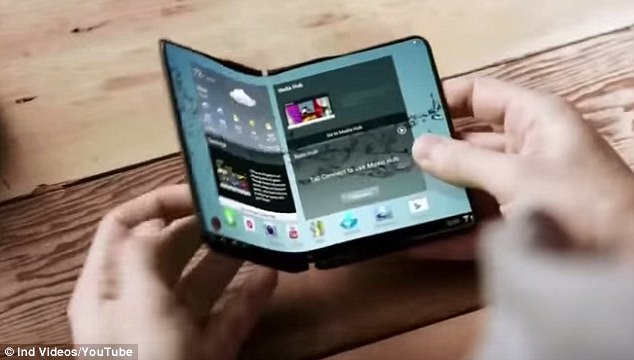Apple is developing a foldable iPhone that can be ‘opened and closed like a book’.
The tech giant has applied for a patent for the unnamed device, and is believed to be working with LG to develop the screen technology.
Samsung is also believed to be working on a similar handset, which could be revealed in January.
According to the patent application, which was spotted by Patently Apple, : ‘An electronic device may have a flexible portion that allows the device to be folded.
‘The device may have a flexible display.
‘The flexible display may have a bending region that allows the display to bend along a bend axis when the device is folded.’



The patent also mentions the device has a MicroOLED screen, a next generation screen technology set to replace the OLED display in the latest iPhone X.
Korean site The Investor, claimed earlier this year the firm is already ‘developing an iPhone with a foldable display’ with the Korean manufacturer.
The folding device could transform from an iPhone to an iPad.
While LG and Samsung are both developing folding screens, it is believed Apple chose to work with LG over fears to avoid privacy issues.
‘LG Display recently created a task force to develop a foldable OLED screen for the new iPhone model, while its parts-making sister firm LG Innotek has also setup a team dedicated to developing the rigid flexible printed circuit board, more widely called RFPCB,’ the Investor says.
‘Panel production could start from 2020,’ it claims.
Samsung has long been rumoured to be developing a radical folding phone – and it could soon see the light of day, it has been claimed.
A support page for the handset has been spotted online weeks after if was certified by Korean authorities.
It is believed the handset could be unveiled at the CES show in Las Vegas in January.


According to the patent application, which was spotted by Patently Apple, : ‘An electronic device may have a flexible portion that allows the device to be folded.
‘The device may have a flexible display.
‘The flexible display may have a bending region that allows the display to bend along a bend axis when the device is folded.’
The patent also mentions the device has a MicroOLED screen, a next generation screen technology set to replace the OLED display in the latest iPhone X.
Korean site The Investor, claimed earlier this year the firm is already ‘developing an iPhone with a foldable display’ with the Korean manufacturer.
The folding device could transform from an iPhone to an iPad.
While LG and Samsung are both developing folding screens, it is believed Apple chose to work with LG over fears to avoid privacy issues.
LG has already reveal several foldable prototype devices, including one that folds over like a book and a second that rolls up much like a newspaper.
In 2014, it showed off a working 18-inch Ultra HD screen that uses a special film instead of plastic as backing.
This allowed the screen to be rolled into a tight tube for transport.
At the time, the company said it could make its debut in 2017.
In May, it debuted a a concept ultra thin ‘wallpaper TV’ less than 1mm thick, and at four lbs (1.9kg) it is so light it can be attached to the wall using just magnets.
LG’s foldable displays use flexible OLED panels and LG has been working to increase durability and yield rate.
Folding display technology is a ways off from launch, and unnamed industry sources believe panel production for an iPhone with a folding display won’t kick off until 2020, which is more than two years from now, according to MacRumours.












